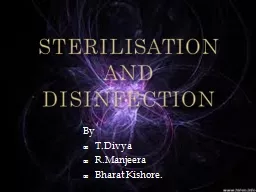

Kishore STERILISATION AND DISINFECTION LABORATORY SAFETY Wear gloves Wash hands after working with infectious materials Disinfect all instruments after use Use water to moisten specimen labels ID: 629478
Download Presentation The PPT/PDF document "By T.Divya R.Manjeera Bharat" is the property of its rightful owner. Permission is granted to download and print the materials on this web site for personal, non-commercial use only, and to display it on your personal computer provided you do not modify the materials and that you retain all copyright notices contained in the materials. By downloading content from our website, you accept the terms of this agreement.
Slide1
ByT.DivyaR.ManjeeraBharat Kishore.
STERILISATION
AND
DISINFECTIONSlide2Slide3
LABORATORY SAFETY
Wear gloves
Wash hands after working with infectious materials
Disinfect all instruments after use
Use water to moisten specimen labels
Disinfect all contaminated waste before discarding
Report to appropriate personnel all accidents or exposures to infectious agentsSlide4
STERILISATION
The process by which an article ,surface or medium is freed of all living microorganisms either in the vegetative or spore state.
Object of
Sterilisation
:
Uses:
-
.to prevent contamination by organisms
in surgery to maintain asepsis
.in food manufacture
.in drug manufacture
Methods
:depend on
purpose,material
and nature of microorganisms to be removed or destroyed
Slide5
DISINFECTION :- destruction or removal of all pathogenic organisms or organisms capable of giving rise to infection.
ANTISEPSIS
:-
prevention of infection usually by inhibiting the growth of bacteria in wounds or tissues.
ANTISEPTICS
:-
chemical disinfectants which can be safely applied on skin and mucous membraneSlide6
BACTERICIDAL AGENTS or GERMICIDES :-those which are able to kill bacteriaBACTERIOSTATIC AGENTS :-
prevent multiplication of bacteria which may however remain alive
CLEANING
:-
an important preparatory role before
sterilisation
by removing soil and other dust , reducing microbial burden making
sterilisation
more effective.
DECONTAMINATION
:-
process of rendering an article or area free of danger from contaminants
.Slide7
A. PHYSICAL AGENTSSunlightDryingDry
heat:flaming,incineration,hot
air
Moist heat :
pasteurisation,boiling,steam
under pressure
Filtration
Radiation
Ultrasonic and sonic vibrations Slide8
B. CHEMICAL AGENTS Alcohols :
ethyl,isopropyl,trichlorobutanol
Aldehydes
:
formaldehyde,glutaraldehyde
Dyes
Halogens
Phenols
Surface active agents
Metallic salts
Gases:ethylene
oxide,formaldehyde,betapropiolactone
Slide9
1.SUNLIGHT
bactericidal
activity
spontaneous
sterilisation
under natural conditions
action is due to
uv
rays
Germicidal
effect due to
uv
and heat rays
2.DRYING
unreliable
spores are unaffectedSlide10
3 .HEATreliableFactors influencingnature of heattemperature and time
no.of microorganisms present
characteristics of organisms
type of material from which the organisms have to be eradicatedSlide11
THERMAL DEATH TIME :-minimum time required to kill a suspension of organisms at a predetermined temperature in a specified environment.STERILISATION TIME
depends on
no. of organisms in suspension
spores
characteristics of organisms Slide12
DRY HEAT FLAMING :
bunsen
flame
INCINERATION
:
an excellent method for safely destroying hospital wastes
Slide13
INCINERATORSlide14
HOT AIR OVEN widely used temperature 160 C
time 1 hour
sterilises
glassware,foreceps,scissors,scalpels,syringes,swabs
Slide15Slide16
Oven is heated by electricityIt is fitted with a fan for even distribution of airShould not be overloaded
Glassware should be perfectly dry before being placed in the oven
180 C –cotton plugs get charred
150 C , 2hrs –instruments used in ophthalmic surgery
150 C , 1hr –oils, glycerol and dusting powder
Oven is allowed to cool slowly for 2 hrs. Slide17
Sterilisation control :Spores of non toxigenic strain of Clostridium tetani
are used
Paper strips impregnated with 106 spores
placed in envelopes
inserted into suitable packs
sterilisationSlide18
Strips removed and inoculated into thioglycollate or cooked meat mediaIncubated for sterility test under strict anaerobic conditions for 5 days at 37 C
Brownes
tubeSlide19
MOIST HEAT 1. Temp. below 100 CPasteurisation of milk : Holder method :63 C , 30 min. Flash process :72 C , 15-20 sec.
Cooled quickly to 13 C Slide20Slide21
Non sporing pathogens destroyedCoxiella burnetti survives holder method
Inspissator
80 C , 5 -10 min.-bacteria ,yeasts moulds
60 C , virusesSlide22
2. Temp. at 100 Ca) Boiling : vegetative bacteria killed
spores not killed
b) Steam at atmospheric pressure 100 C
Koch or Arnold steamer Slide23
STEAMERSlide24
TYNDALLISATION or INTERMITTENT STERILISATION100 C ,20 min , 3 successive daysSlide25
C) Steam under pressure :Temp. 108 C -147 C : dressings,instruments,laboratory ware,media,pharmaceutical products sterilised
For aqueous solutions 108 C -126 C
Steam
sterilisers
laboratory autoclaves
hospital dressing
sterilisers
bowl and instrument
sterilisers
rapid cooling
sterilisers
Slide26
HOSPITAL DRESSING STERILISERSlide27
INSTRUMENT STERILISERSlide28
RAPID COOLING STERILISERSlide29
PRESSURE COOKERSlide30
LABORATORY AUTOCLAVEPRINCIPLE –Water boils when its
vapour
pressure equals that of the surrounding atmosphere.Slide31
e
LABORATORY AUTOCLAVESlide32
DEFECTS The method of air discharge is inefficient if air is not completely removed , the desired temperature is not attained
There is no facility for drying the load after
sterilisation
and before taking it out.
STERILISATION CONTROL
:
spores of Bacillus
stearothermophilus
are used as the test organism.
Spores require 121 C , 12 min. to get killedSlide33